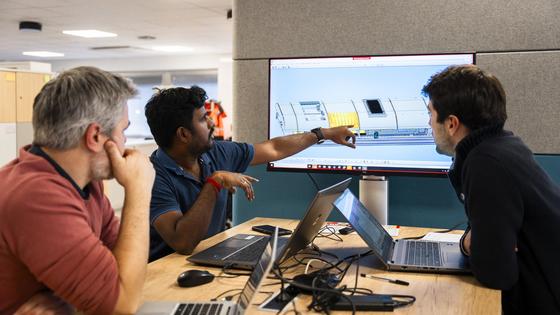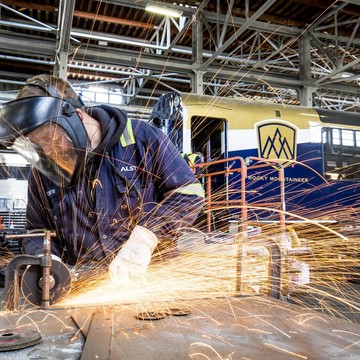
Serviceability by design: Redefining cost-efficient rail systems
Serviceability by design: Redefining cost-efficient rail systems

Morgane Gouyon-Rety, Product Development and Modularisation Director for the Rolling Stock and Components product line, and Eric Holmes, Vice President, Services Development, explain how the maintenance teams' return on experience informs the design of new trains, helping to reduce long-term costs.
What is ‘design for serviceability’? Why is it considered essential in today’s rail industry?
Morgane Gouyon-Rety: Design for serviceability is the practice of engineering train design so that maintenance tasks, whether routine or corrective, can be performed safely, efficiently and at the right quality throughout the train’s lifecycle. When a product has not been designed with service in mind, it is a real pain to maintain and is costly over time. If you have not designed your train with access in mind, for instance, repairing components is more difficult, takes longer and costs more.
At Alstom, we have people from our Services teams embedded into the design process, so we have that hands-on experience informing the design decisions we take. Alstom both builds and services trains, so it is clearly in our interest to ensure that trains are well thought out, well designed and easy and less costly to maintain.
Eric Holmes: Our customers invest a tremendous amount of money in procuring new rolling stock and they want to maximise the operational utilisation of their trains, whether carrying passengers or moving freight. Therefore, by design, we should ensure that their assets spend the least possible time in the depot.
Designing for service also means thinking about how we can interrogate and fault-find various defects as quickly as possible so that we can fix them reliably the first time. The Alstom Services portfolio and global footprint across a range of train products is second to none. Our knowledge and experience in terms of ‘design for serviceability’ has been developed over more than 25 years, and this is a key differentiator for Alstom and our customers.

What do rail manufacturers need to consider in design to ensure serviceability? How does Alstom’s full-lifecycle role help us deliver on that?
EH: As an organisation, we innovate continuously by developing tools to digitally assess maintainability and accessibility throughout the design phase. We configure our components to make them more maintainable, prioritising the components that we need to service more frequently.
In addition to accessibility and maintainability, we also need to look at maintenance periodicities, and how to design our products so they can be maintained at the optimal frequency. This can include the ability of our components to transmit data remotely, informing us of their health and condition, enabling predictive maintenance.
MGR: More and more of our systems on board and wayside are digital, and we collect a lot of data. We can now access near-instantaneous data on passenger flows and the condition of the trains. This means we can adapt the way we service our trains in almost real time. We can then feed service return of experience back into the design of our trains.
As well as our Services arm, we are also working with operations and industrial departments to ensure that what we are designing can be easily assembled and built. Because Alstom is present across the whole value chain, it puts us in a unique position to deliver true value across the board to operators.

What are the real-world benefits of serviceability in train design for customers and maintenance teams?
EH: Simply put, it gives us the flexibility to design the train and the service operation around optimising the availability of assets. By designing digital capability into the train (or the depot) to provide real-time data relative to the condition of key components, we can automate tasks that would otherwise be manual and, therefore, optimise component life.
On our Aventra™ platform, adoption of this strategic approach to train design has reduced direct maintenance cost by more than 20% compared to the previous platform for that market sector.
MGR: Another aspect is modularisation. Across different products, we are pushing shared modules, which makes it easier for Alstom and its customers to understand and maintain parts. We can streamline stock, as there are fewer types of spare parts needed.
It also opens the door to backward compatibility, where we can swap one module for an updated one. Take an HVAC system. It’s the second highest consumer of power on board a train, after the traction system. Offering operators a more energy-efficient model that fits the same on-board space delivers significant value.
EH: The greater we can standardise, the more reliably we can produce a very high-quality product that works out of the box, and that is of tremendous value to customers.

How does design for serviceability impact total cost of ownership for operators?
EH: Broadly speaking, total cost of ownership refers to all the costs associated with a product over its entire lifespan. This includes the acquisition cost (the initial purchase), lifecycle costs such as maintenance and servicing, energy costs incurred during operation, and disposal costs at the end of the product’s life.
Our primary focus with design for serviceability is lifecycle cost optimisation. At the product level, good accessibility and ease of maintenance reduce the time taken and improve the quality of what we do, thereby reducing the cost.
We also optimise the maintenance periodicities of the components and sometimes we design a better component. For example, we select a higher-grade bearing to get better component life out of rotating equipment, all of which reduces product lifecycle costs and increases the operator’s asset utilisation.
At the fleet level, this impacts the total cost of ownership, as the operator can deliver their service with fewer assets and a smaller depot footprint.
MGR: Another aspect is predictive maintenance. It is always better to intervene ahead of a failure than to have a train failure during operation. Our customers not only save money but are also in a position to extensively de-risk their operations through our predictive maintenance technologies.

How is technology shaping Alstom’s approach to design for serviceability?
An example would be the predictive health monitoring capability we have on board our Avelia™ high-speed trains, where we have smart sensors on various components that are historically maintained through manual inspection, such as wheel bearings.
Another example is air conditioning components such as air filters. We monitor the air flow to detect when the filter is getting clogged. In some applications, we have been able to double the time between maintenance periods.
Some trains have multiple systems spread across the entire train and are fully predictive health monitoring (PHM)-enabled trains. This has produced a significant reduction in the direct maintenance costs of the train, and has enhanced the operator’s ability to increase asset utilisation.
MGR: This also plays into the green strategy of Alstom. If you don't need to replace your filters as often, this is good for the environment. Improving the performance of the HVAC or traction system reduces energy use, and therefore CO2 emissions. One thing that I personally like in this industry is that it is often possible to go for win-win solutions!




